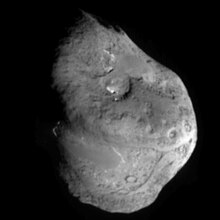
Back نواة المذنب Arabic Ядро каметы Byelorussian Kometární jádro Czech Комета тĕшĕ CV Kometkerne Danish Kometa kerno Esperanto Núcleo (cometa) Spanish هسته (دنبالهدار) Persian Noyau cométaire French Núicléas (réalteolaíocht) Irish
This article needs to be updated. (July 2020) |

The nucleus is the solid, central part of a comet, formerly termed a dirty snowball or an icy dirtball. A cometary nucleus is composed of rock, dust, and frozen gases. When heated by the Sun, the gases sublime and produce an atmosphere surrounding the nucleus known as the coma. The force exerted on the coma by the Sun's radiation pressure and solar wind cause an enormous tail to form, which points away from the Sun. A typical comet nucleus has an albedo of 0.04.[1] This is blacker than coal, and may be caused by a covering of dust.[2]
Results from the Rosetta and Philae spacecraft show that the nucleus of 67P/Churyumov–Gerasimenko has no magnetic field, which suggests that magnetism may not have played a role in the early formation of planetesimals.[3][4] Further, the ALICE spectrograph on Rosetta determined that electrons (within 1 km (0.62 mi) above the comet nucleus) produced from photoionization of water molecules by solar radiation, and not photons from the Sun as thought earlier, are responsible for the degradation of water and carbon dioxide molecules released from the comet nucleus into its coma.[5][6] On 30 July 2015, scientists reported that the Philae spacecraft, that landed on comet 67P/Churyumov-Gerasimenko in November 2014, detected at least 16 organic compounds, of which four (including acetamide, acetone, methyl isocyanate and propionaldehyde) were detected for the first time on a comet.[7][8][9]
- ^ Robert Roy Britt (29 November 2001). "Comet Borrelly Puzzle: Darkest Object in the Solar System". Space.com. Archived from the original on 22 January 2009. Retrieved 26 October 2008.
- ^ "ESA Science & Technology: Halley". ESA. 10 March 2006. Retrieved 22 February 2009.
- ^ Bauer, Markus (14 April 2015). "Rosetta and Philae Find Comet Not Magnetised". European Space Agency. Retrieved 14 April 2015.
- ^ Schiermeier, Quirin (14 April 2015). "Rosetta's comet has no magnetic field". Nature. doi:10.1038/nature.2015.17327. S2CID 123964604.
- ^ Agle, DC; Brown, Dwayne; Fohn, Joe; Bauer, Markus (2 June 2015). "NASA Instrument on Rosetta Makes Comet Atmosphere Discovery". NASA. Retrieved 2 June 2015.
- ^ Feldman, Paul D.; A'Hearn, Michael F.; Bertaux, Jean-Loup; Feaga, Lori M.; Parker, Joel Wm.; et al. (2 June 2015). "Measurements of the near-nucleus coma of comet 67P/Churyumov-Gerasimenko with the Alice far-ultraviolet spectrograph on Rosetta" (PDF). Astronomy and Astrophysics. 583: A8. arXiv:1506.01203. Bibcode:2015A&A...583A...8F. doi:10.1051/0004-6361/201525925. S2CID 119104807.
- ^ Jordans, Frank (30 July 2015). "Philae probe finds evidence that comets can be cosmic labs". The Washington Post. Associated Press. Archived from the original on 23 December 2018. Retrieved 30 July 2015.
- ^ "Science on the Surface of a Comet". European Space Agency. 30 July 2015. Retrieved 30 July 2015.
- ^ Bibring, J.-P.; Taylor, M.G.G.T.; Alexander, C.; Auster, U.; Biele, J.; Finzi, A. Ercoli; Goesmann, F.; Klingehoefer, G.; Kofman, W.; Mottola, S.; Seidenstiker, K.J.; Spohn, T.; Wright, I. (31 July 2015). "Philae's First Days on the Comet – Introduction to Special Issue". Science. 349 (6247): 493. Bibcode:2015Sci...349..493B. doi:10.1126/science.aac5116. PMID 26228139.
© MMXXIII Rich X Search. We shall prevail. All rights reserved. Rich X Search